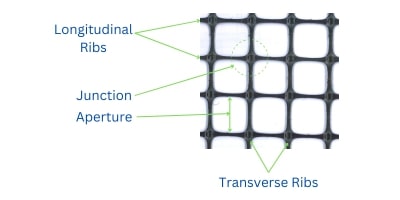Geogrid aperture sizes: Impact on soil reinforcement
With a principal function of reinforcing soil, geogrids find uses across industries due to their tensile strength and ability to distribute loads across a variety of subgrades. But did you know that the aperture of a geogrid is not fixed? What is the optimal aperture size for geogrids in your next project? This blog details geogrid apertures and their impact on different geotechnical applications. There is no one size fits all solution for soil reinforcement, soil improvement, or construction, as each project brings unique challenges. That is why, at Strata Geosystems, our state-of-the-art manufacturing facility allows us to adapt to your needs
Definition, importance and physical properties of a geogrid
A geogrid, as we know, is a geosynthetic material used to reinforce soil. By locking aggregate or other fill materials into place, it improves load distribution, can reduce the required thickness of the aggregate base/sub-base layers, and stabilizes the soil structure.
What is a geogrid aperture?
In the process of soil improvement, the aperture is one of the key elements in conjunction with the soil or material being used as in-fill. A geogrid’s aperture refers to the void space in its grid-like structure. These apertures come in various shapes and sizes, designed to interlock with the surrounding soil and aggregate materials held in place. Strata Geosystems has a wide range of aperture sizes for geogrids. In the case of our uniaxial geogrids, the standard aperture size is 40mm to 400 mm and for biaxial geogrids is 20mm to 150mm.
Importance of aperture size in geogrid design
The size of these apertures is a critical design element, as it dictates the level of interlock and confinement achievable with the soil. The size of these apertures influences the geogrid’s ability to stabilize the ground, making it a crucial factor in the design and selection process. It’s worth noting that ultimately, the aperture size impacts the tensile strength, and ultimate junction strength –which is why it’s a factor to consider. The physical properties of a geogrid roll affect how much load it can carry, over what area.

The relationship between aperture size, soil confinement, and deformation characteristics is complex. Aperture size dictates the level of soil confinement and the geogrid’s capacity to interlock with soil particles. Relative to the size of the fill material, smaller apertures can enhance soil confinement by achieving greater interaction between the soil and the geogrid. This heightened confinement can improve the load-bearing capacity of the soil-geogrid system by as much as 2-5x depending on the soil itself, leading to superior load distribution and minimized vertical and lateral deformations. Conversely, larger apertures or inadequate confinement can result in excessive soil movement, reduced stability, and increased deformation levels. As such, choosing the “right” aperture size is critical to the structural integrity of geogrid-reinforced systems.
Case studies on geogrid applications by Strata Geosystems
Our case studies often provide us a chance to review the kind of issues we came across and the learnings from them. Here, we present two instances of how we worked with geogrids, to solve very specific problems.
1.Retaining wall reinforcement for Riyadh Metro with StrataGrid™ 60
In Riyadh, Saudi Arabia, the Riyadh Development Authority faced a challenge in constructing retaining structures for access to the metro station within the densely populated city. To solve this, StrataGrid 60 was selected for reinforcing a vertical mechanically stabilized earth (MSE) wall, providing a robust solution to the space constraints and structural demands of the area.
StrataGrid 60 facilitated local infill use, lowering project costs and minimizing environmental impact. The aperture size also facilitated optimal soil interaction, critical for load distribution and long-term stability of the wall. This approach not only supported the wall’s load-bearing capacity but also offered an eco-friendly solution by minimizing resource consumption.
Using StrataGrid 60, the project achieved a cost-effective, sustainable reinforcement structure within the city’s limited space, successfully meeting both structural and environmental goals.
2.StrataGrid™ geogrid for retaining wall construction in Aqaba, Jordan:
The Aqaba Development Authority, Jordan required a technically superior and economical solution for the movement of heavy trailers towards their container yards lying in marine areas with weak sub-bases. Strata’s geotechnical experts designed a block fascia retaining wall, using site-won material and previously-made blocks lying at the site. The design would accommodate the high contact pressures from vehicles carrying fully loaded containers, which can exceed 600-800 kPa. The toe of the RS wall was provided with three layers of stone-filled gabions to protect against scouring throughout the life of the structure. The high-performance geogrid product, StrataGrid from Strata was used for this project. Geogrids with different aperture sizes were used in a strategic way to achieve the required results. StrataGrid SGU 40 and SGU 120 were chosen for their optimal engineering characteristics. SGU 120 uniaxial geogrids gave more strength and load distribution characteristics as the primary reinforcement layer, and SGU 40 would provide more support and stability with minimum usage of materials and cost as the secondary reinforcement. Using locally available materials saved both time and costs, reducing the need for specialized heavy machinery and labor compared to conventional concrete structures. While the facing blocks could be placed manually, standard earth-moving equipment was still required for backfilling and compaction. The use of StrataBlock also provided a pleasant aesthetic appearance, conforming to the architectural requirements. Explore more about this case study here.
Strata Geosystems can help you answer your doubts related to choosing the right aperture size for your next project involving geogrids. With expertise in geogrid technology, we ensure designs tailored to your soil reinforcement requirements. Contact us today to explore how our geogrid solutions can enhance the stability and performance of your construction projects. Let us be your partner in achieving durable and efficient geotechnical solutions tailored to your specific requirements.
